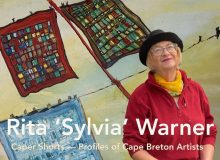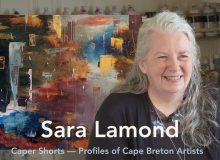Astua’sij — Where paths meet — an exhibit
A show of emerging indigenous artists on display at the J Franklin Wright Gallery at the Port Hawkesbury Civic Centre made me reflect on the coming of spring
Spring takes its own time and starts before we can see it. The earth prepares itself beforehand as the ground thaws and energy stirs in the plants and animals. When Spring becomes visible in nascent tender shoots of grass and flowers, swelling buds, returning birds and animal movement, the emergence brings joy.
On April 6, we attended Astua’sij — “Where Paths Meet ” — an exhibit of emerging indigenous artists at the J. Franklin Wright Gallery in Port Hawkesbury. The displayed creations of four Mi’kmaw artists there evoked such feelings of renewal on an early spring day.
The simple, spare presentation included a traditional Mi’kmaw peaked cap; ribbon skirts; moose antler, bead and feather jewelry; animal pelt clothing and bag; whale baleen earrings; a turned maple burl bowl; beaded earrings and medallions; and a traditionally inspired motif print. All of the art stirred my curiosity about deeper meaning and purpose. Like a gardener scratching at the earth to uncover the growth beneath, I was grateful for this opportunity to learn more.
Tracey Marshall of Potlotek First Nation became interested in traditional women’s peaked caps after taking a workshop on their meaning and how to make them. The beaded wool cap was finely detailed with a ma’susi or fiddlehead motif, her personal, contemporary touch to an ancient design. Beading is a kind of contemplation allowing her to “think her thoughts.” From her display I learned that peaked caps “represent who we are and help tell our stories”.
Marisa Prosper of Pictou Landing is the creator of moose antler, feather and bead jewelry – earrings and necklaces. Cross sections of antler combined with stones join the animal and mineral worlds. From her creations I learned about the belief that everything is alive and imbued with sentience and that we are all related. The moose is considered sacred and its meat is both a delicacy and medicine. Hunters share it among family members and community. The moose antler jewelry spoke to me about the interconnectedness and reciprocity of the animal-human relationship.
Marissa displayed two ribbon skirts as well, one adult and one child-sized. From her bright, luminous sewn design with horizontal rows of ribbon and a mother and child appliqué on the bigger one, I learned that each of these skirts are an individual expression of womanhood. They tell a story and reflect their maker. They are symbols of resilience, survival and pride, worn to sacred ceremonies or whenever strength is needed and important ancestral information is shared
Joef Bernard from Eskasoni works with animal fur pelts with the skills taught to him by his father and elders, connecting him to the land. The coat and utility bag were made according to ancestral designs and the pelts ethically sourced from roadkill and found resources following the Mi’kmaw law, Netukulimk – to only take what is needed and to return unused parts to the land. A versatile maker, his display also included lustrous black whale baleen earrings and a turned maple burl bowl. From his artist’s statement I learned that the Mi’kmaw language is descriptive and holds knowledge about the land and animals within its structure.
Laylia Bennett of Bear River First Nation is of both Mi’kmaw and Acadian descent. She makes finely detailed beaded earrings and medallions respecting traditional methods and designs. I very much enjoyed her pink and white dangling cloud earrings recalling the sky on a windy day. She believes that identity is inseparable from creation. She runs a successful small business selling her art. I also admired her strawberry pattern earrings created with bright tiny glass beads using a popcorn stitch. She told me that each earring took over nine hours to make and that many of her motifs represent food medicines like berries. Her artist’s statement explained, “Laylia strives to make pieces that evoke happiness and can be enjoyed by anyone.” From her I learned that beading can be grounding and healing of intergenerational wounds.
Kayla Rudderham, who hosted the opening, is an independent curator, a Mi’kmaw and settler artist and teacher. As the Emerging Indigenous Curator at the Cape Breton Centre for Craft and Design, which created the event, her goal is to shine a light on and preserve traditional L’nu art practices. This is accomplished through community outreach, interconnectivity and partnerships. “Radical acts of care” influence her practice. As an artist, Kayla works in drawing, printmaking, and beadwork. From her I learned that the traditional Mi’kmaw eight pointed star pattern with interconnected lines on the exhibit poster and the “C” shaped hieroglyphs on signage at the event both symbolizes paths coming together, bridging the gap of exclusion. I believe that those symbols were aptly chosen and reflected the spirit of the event.
In her opening statement at the exhibit Kayla said, “It’s important for the communities here in Unama’ki to have opportunities to spend time with these artist’s works and perspectives.”
The exhibit runs until May 14, 2023 at the J Franklin Wright Gallery, Port Hawkesbury Civic Centre, 606 Reeves St.
- Woman’s peaked cap by Tracy Marshal
- Ribbon skirts by Marissa Prosper.
- Animal fur pelt coat and utility bag by Joef Bernard.
- Beaded jewelry by Laylia Bennett

Author details
Elaine Mandrona, in addition to being a writer, is a painter and sculptor. She moved to Cape Breton permanently in 2021.











